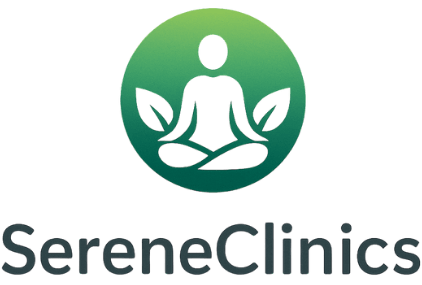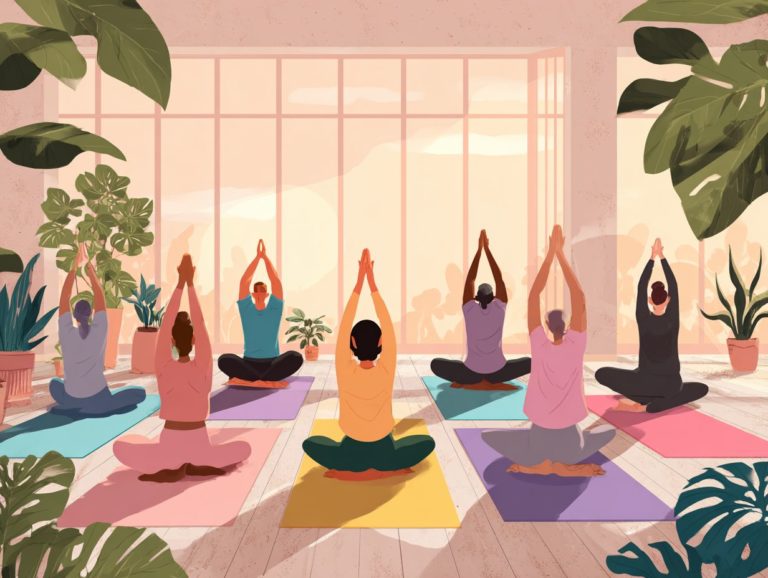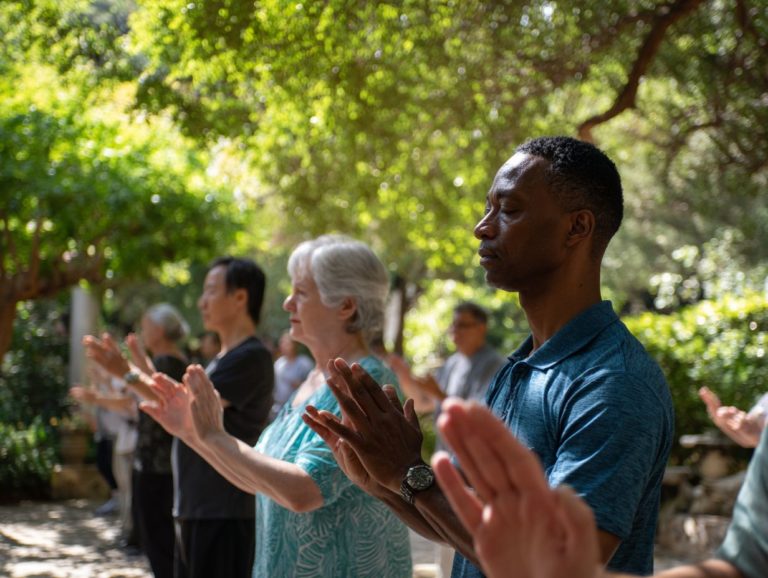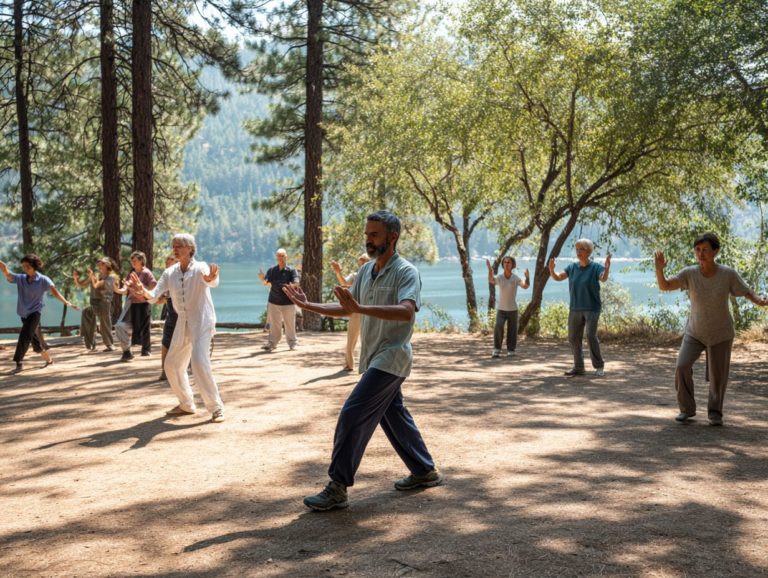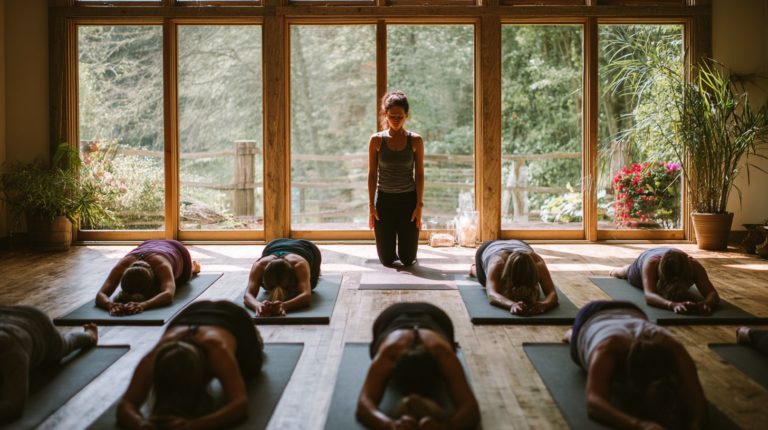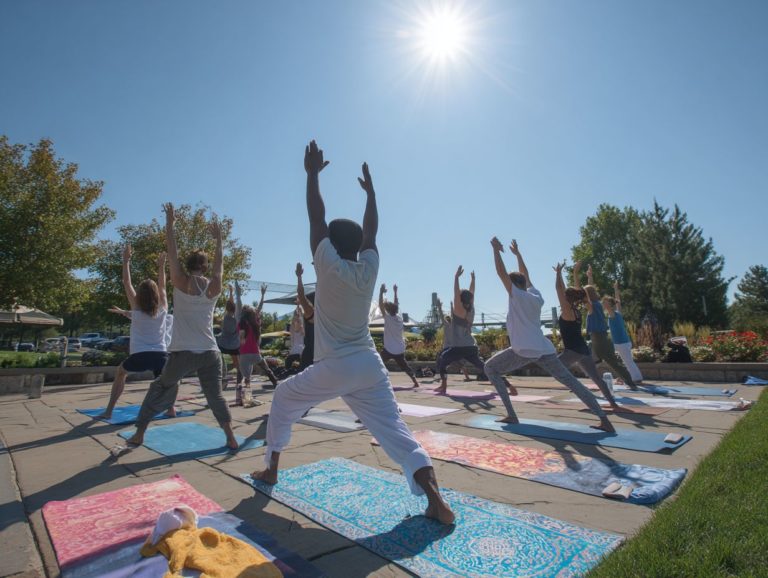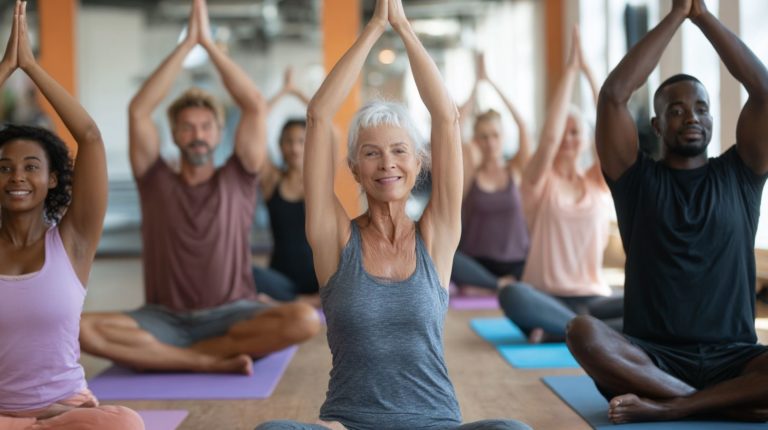How to Prepare for a Yoga Retreat: Essential Tips
Embarking on a yoga retreat can feel like a breath of fresh air-until planning mistakes trip you up. Ashley Baer and Gloria Baraquio run retreats and show up on Insight Timer. They provide help for people at every skill level, from those just starting out to experienced ones. This guide gives your target audience self-care ideas and simple preparation advice to plan a purposeful, refreshing break without the hassle.
Key Takeaways:
Contents
- 1 Understanding Yoga Retreats
- 2 Yoga Practitioners in the US by Age Group
- 3 Choosing the Right Retreat
- 4 Setting Personal Intentions
- 5 Physical Preparation
- 6 Mental and Emotional Prep
- 7 Packing Essentials
- 8 Health and Safety Measures
- 9 Frequently Asked Questions
- 9.1 What essentials should I pack for a yoga retreat?
- 9.2 How can I physically prepare my body before attending a yoga retreat?
- 9.3 What mental preparation is key for a successful yoga retreat?
- 9.4 Should I adjust my diet before a yoga retreat, and how?
- 9.5 How do I choose the right yoga retreat for my needs?
- 9.6 What should I expect and do on the first day of a yoga retreat?
Understanding Yoga Retreats
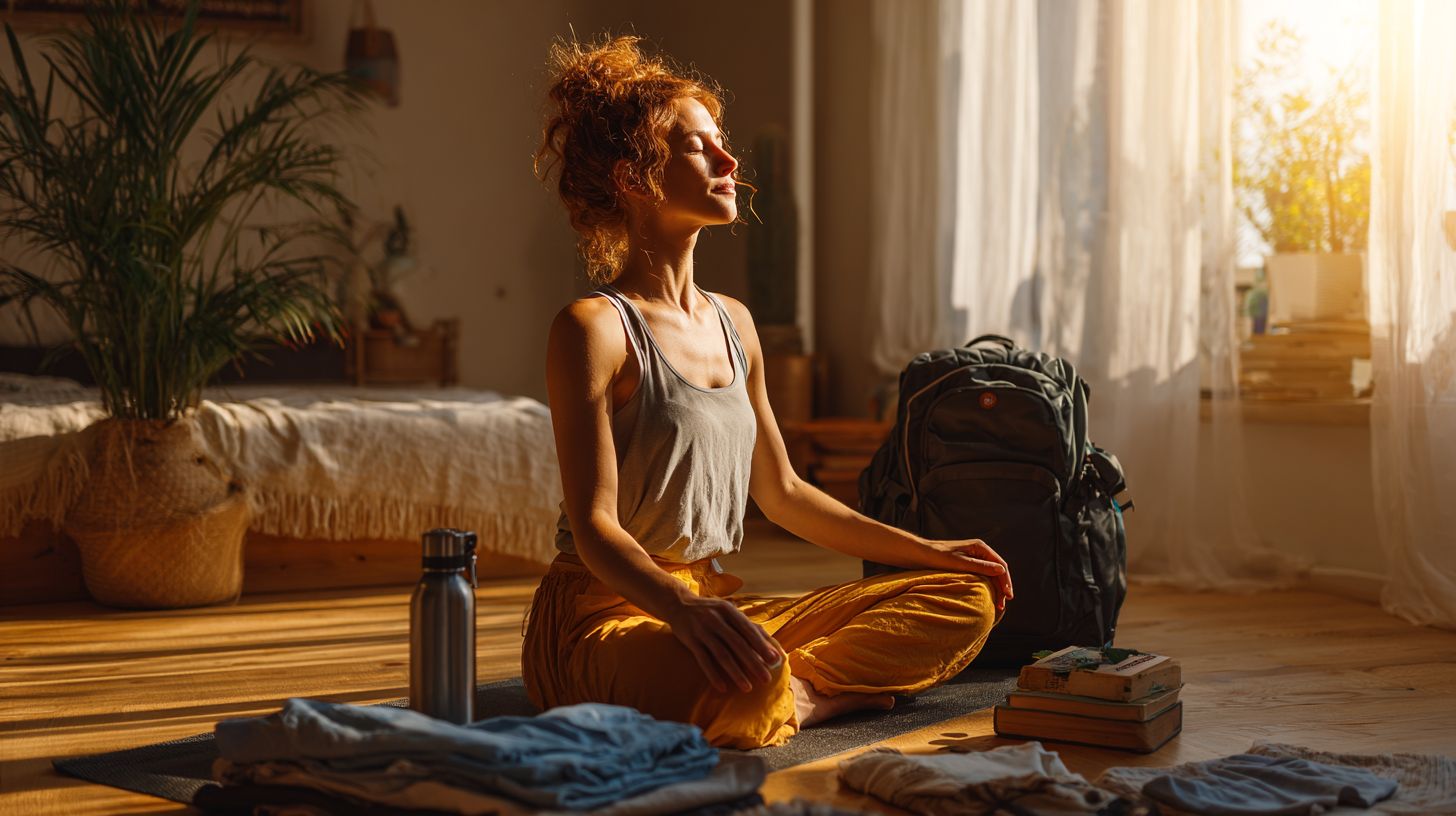
Yoga retreats offer immersive escapes blending yoga practice with self-care, drawing over 2 million participants annually worldwide according to the Global Wellness Institute. This aligns with findings from McKinsey, which highlights the expanding scope of wellness trends driving such participation. Related insight: How to Get Yoga Certifications: Types and Requirements
Yoga Practitioners in the US by Age Group
Yoga Practitioners in the US by Age Group
Age Demographics: Percentage of Practitioners
The Yoga Practitioners in the US by Age Group data offers a snapshot of how yoga’s popularity varies across different generations, highlighting its broad appeal for physical, mental, and wellness benefits. This demographic breakdown reveals that yoga has evolved from a niche practice to a mainstream activity, with participation influenced by lifestyle demands, health awareness, and accessibility through studios, apps, and online classes.
Age Demographics show a clear distribution of practitioners: the largest group is 30 to 39 years at 43%, followed by 40 years and above at 30%, 18 to 29 years at 19%, and below 18 years at a modest 8%. This skew toward middle adulthood suggests yoga’s role in managing stress, improving flexibility, and supporting work-life balance for busy professionals and parents in their prime earning and family-building years.
- Below 18 years (8%): Younger practitioners, often introduced through school programs or family influence, benefit from yoga’s focus on building healthy habits early. However, lower participation may stem from competing activities like sports or limited access in educational settings, indicating room for growth in youth wellness initiatives.
- 18 to 29 years (19%): This millennial cohort engages yoga for stress relief amid career starts and social pressures. Social media trends and affordable online classes have boosted accessibility, though percentages are moderate, possibly due to preferences for high-intensity workouts.
- 30 to 39 years (43%): Leading professionals practice yoga for overall health during midlife pressures. Improved posture, lower anxiety, and more energy match what people want, so many join through work wellness programs and group classes.
- 40 years and above (30%): Older adults practice yoga for joint health, balance, and chronic condition management, with gentler styles like Hatha or restorative yoga gaining traction. Baby boomers getting older are adopting yoga, which shows its role in preventing health problems, backed by doctors’ support.
These numbers show that yoga works for people of all ages. Interest is highest among those aged 30 to 39, because of current stresses. As awareness grows, especially post-pandemic, initiatives targeting younger demographics could further diversify participation, promoting lifelong wellness in the US.
Types of Retreats Available
Yoga retreats take many forms, such as mindfulness retreats that focus on guided meditation, which 60% of participants pick to find calm, or vinyasa yoga classes that create heat by moving through poses.
| Type | Focus | Duration | Best For | Examples |
|---|---|---|---|---|
| Mindfulness Retreat | Meditation/sound healing | 3-7 days | Stress relief | Insight Timer-led sessions |
| Vinyasa Yoga | Flowing sequences | 5 days | Energy boost | Bali venues |
| Yin Yoga | Passive holds | 4 days | Flexibility | Catskills centers |
| Eco-Friendly | Sustainable practices | 7 days | Nature lovers | Heathen Hill |
Vinyasa suits energetic, active people. It includes smooth movements that build strength in the circulatory system and lungs.
Yin aids those with tight muscles or joint issues. It uses soft, prolonged poses that improve flexibility.
A 2022 Yoga Journal study found 78% satisfaction in Vinyasa for vitality boosts versus 85% in Yin for deep relaxation, ideal for customizing based on body type. Worth exploring: Body & Brain Yoga: Features, Classes, and Benefits
Benefits for Beginners vs. Advanced Practitioners
Beginners gain foundational confidence with 80% reporting reduced anxiety after retreats per a UCLA study, while advanced practitioners deepen skills, achieving 25% faster progress in poses like downward dog.
UCLA’s 2021 mindfulness research indicates that retreats improve emotional regulation by 65%, and participants keep those gains for up to a year.
For beginners, consider the Restore & Renew Retreat: a novice overwhelmed by work stress attends sessions with gentle Hatha flows and breathwork, emerging with tools to manage anxiety via daily 10-minute meditations.
Advanced yogis at the Mindful Money Retreat blend asana practice with financial wellness seminars, like budgeting visualizations in warrior pose, accelerating pose mastery.
Invest $1,500 in such a retreat for six months of habits-daily journaling and yoga-saving $2,000 in therapy costs through reduced stress-related visits, per APA data.
Choosing the Right Retreat
Selecting a yoga retreat involves aligning location and style with your needs, ensuring accessibility for global audiences via direct flights to spots like Bali.
Researching Locations and Styles
Start by browsing platforms like Yoga Retreats online course directories, where Bali tops lists for 70% of tropical seekers, offering lush retreat centers amid rice terraces.
Next, use these steps to narrow your search and book faster. It will take about 45 minutes total.
- Use the free Yoga Retreats directory search (10 mins) to filter alternatives like Ocho Rios, Jamaica, for serene beach vibes, or Ubud, Bali, for intensive yoga amid volcanoes-avoid overbooked peak seasons by checking dates early.
- Dive into reviews on the Outside+ app (15 mins), prioritizing user feedback on class styles, such as vinyasa flow versus restorative sessions, to match your fitness level.
- Verify availability and book via WeTravel (20 mins), which integrates secure payments and group options.
Common pitfalls include overlooking Oahu, Hawai’i’s summer crowds; counter this by cross-referencing quieter Pali Mountain retreats or San Bernardino’s desert alternatives for uncrowded solitude.
Assessing Your Experience Level
Evaluate your level by tracking current practice hours-beginners under 2 hours weekly suit leaders like Ashley Baer’s gentle intros, while advanced match Gloria Baraquio’s intensive flows.
To improve this assessment, try these three methods for accurate self-evaluation.
- First, take a self-quiz in the Insight Timer app. Rate your skill at basic poses, such as child’s pose where you feel 80% comfortable, or downward dog to test your flexibility.
- Second, review past class notes-if vinyasa sequences feel overwhelming, stick to beginner levels to build confidence.
- Third, check the retreat leaders’ bios: Ashley Baer runs sessions for beginners, while Gloria Baraquio works with pros on flowing sequences.
Track progress in practice logs; a 50% improvement in session duration signals readiness to level up. Avoid overestimating your skills, which often leads to frustration and injury-start conservatively for sustainable growth.
Budget and Duration Considerations
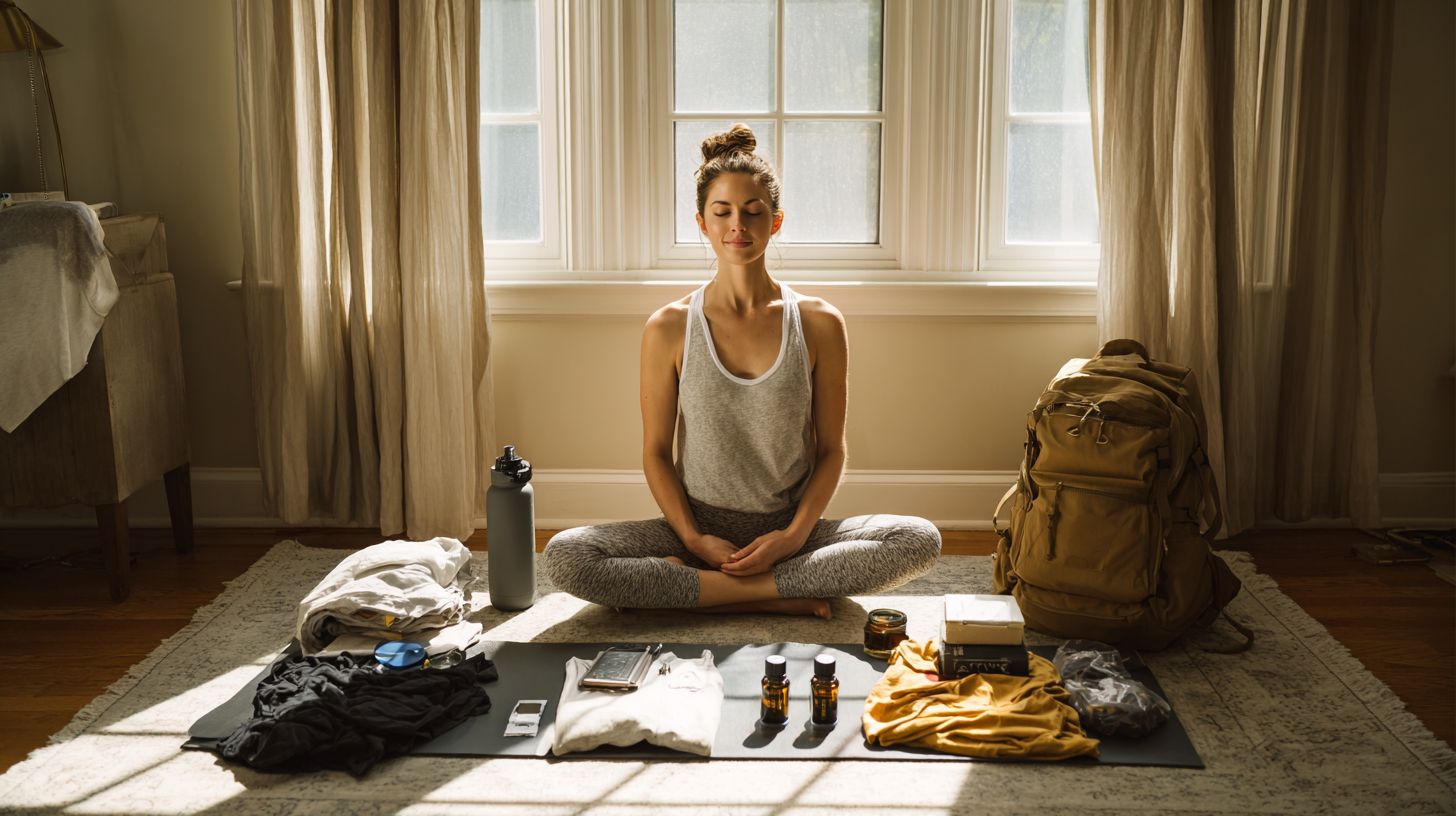
Retreat costs average $1,500-$3,000 for 5-7 days, with pricing considerations like all-inclusive healthy food adding 20% value over budget options.
According to BookRetreats.com’s 2023 averages, wellness retreats yield a 15-25% improvement in participant well-being metrics.
For example, a four-day mindfulness retreat in Bali costs $800, or $200 per day. Follow-up surveys show a 15% drop in stress as return on investment, which means higher productivity worth $1,200 each year for professionals.
A 7-day yoga retreat for advanced students in the Catskills costs $2,500, or $357 per day. It includes group meals that help make business connections worth $500.
To get better value, bargain for extras like spa sessions by pointing out early booking discounts; combining transport can save 10-15% overall.
Setting Personal Intentions
Personal intentions guide your retreat itinerary, turning vague hopes into focused paths for transformation amid yoga practice.
Defining Your Goals
Use the SMART method to set goals. For example, “Practice yoga every morning to get better” has definite actions, such as completing 5 sessions.
To create such goals for your retreat, follow these three steps, which include time estimates.
- Reflect on pain points for 10 minutes: Jot down three specific issues, like chronic stress from work, emotional burnout, or lack of focus-use a journal or notes app to list them honestly.
- Spend 10 minutes thinking about the retreat’s purpose. Open the Insight Timer app and follow its instructions on mindfulness retreats. This connects your problems to bigger goals, like renewal.
- Take 15 minutes to write down one or two SMART goals. Set goals that are specific, measurable like 20-minute sessions, achievable, relevant, and time-bound. Avoid vague goals by adding metrics; as Theodore Roosevelt said, ‘Do what you can, with what you have, where you are’-intentional living demands action.
This process takes under 40 minutes total, fostering deeper growth.
Journaling for Clarity
Journaling clarifies intentions by asking questions like “What stops my yoga practice?” A 2022 study in the Journal of Positive Psychology found that this increases knowledge by 40%.
To start, follow these numbered steps with tool recommendations for effective journaling before a yoga retreat.
- Choose a simple notebook or the Day One app (free, with 5-minute setup via app store download) to capture thoughts easily.
- Commit to daily 10-minute entries tracking emotions and obstacles, such as ‘Tight hips from desk work hinder my downward dog-I’ll stretch evenings.’
This builds habits without overwhelm. - Review weekly for 15 minutes to spot patterns, like recurring stress themes.
Use phone reminders to stay consistent. One note could sayProcrastination stops practice-plan 20-minute sessions each day.” This helps your self-improvement goals.
Consistent practice enhances self-awareness, as supported by the study’s findings.
Physical Preparation
Physical preparation builds resilience for intense yoga practice, such as the integrated approach in Body & Brain Yoga. It increases flexibility and strength, and improves nutrition and recovery over 4-6 weeks.
Building a Consistent Yoga Practice
Establish consistency with 3 weekly 45-minute sessions using apps like Down Dog, progressing from 20 to 60 minutes over a month.
To build this habit, follow these actionable steps:
- Use Google Calendar to schedule sessions. Plan for three times each week in the morning, and start with 20 minutes per session to begin slowly.
- **Choose guided flows** via the Down Dog app for customizable vinyasa sequences, or supplement with free 30-minute YouTube classes from AdventChannel for variety.
- **Track progress** with the Yoga Studio app, logging poses and sessions to monitor improvements.
Aim for a 2-hour weekly buildup; pair sessions with your coffee ritual to avoid skipping. A 2020 Harvard study shows consistent yoga reduces stress by 30%, enhancing adherence.
Improving Flexibility and Strength
Target flexibility with yin yoga holds of 3-5 minutes per pose, boosting hamstring reach by 15% in 4 weeks per ACE Fitness research.
To build this routine, start with a 20-30 minute session 3-4 times weekly.
- Begin in Child’s Pose for 3 minutes to warm up, then transition to Sphinx (3-5 min) for spinal release.
- Follow with Dragon Pose (4-5 min per side), targeting hamstrings by stacking hips over the front knee.
- End with Legs-Up-the-Wall (5 min) for recovery.
- Get a yoga mat and download a free app like Insight Timer to time your poses. Take deep breaths and do not push too hard.
Per a 2020 ACE study, consistent practice yields 15% improved reach, reducing injury risk by 20%.
Warm up first to prevent over-stretching.
Pre-Retreat Nutrition Plan
Adopt a plant-based plan with 50g daily protein from quinoa and nuts, accommodating dietary restrictions like veganism for sustained energy.
To implement this, follow these steps:
- Use the free MyFitnessPal app to log your protein intake accurately;
- Shop weekly for anti-inflammatory staples like berries, spinach, and almonds on a $50 budget;
- Prep meals in 30 minutes daily to avoid the common mistake of relying on processed foods, as Harvard’s 2023 nutrition guidelines emphasize whole plants for reducing inflammation risks by 20-30%.
Sample 7-day plan: Days 1-3
- Breakfast: Oatmeal with nuts (300 cal, 15g protein);
- Lunch: Quinoa salad (400 cal, 20g protein);
- Dinner: Lentil stir-fry (500 cal, 15g protein).
Days 4-7: Rotate with nut-based smoothies and veggie bowls for variety, totaling ~1,800 cal/day.
Rest and Recovery Strategies
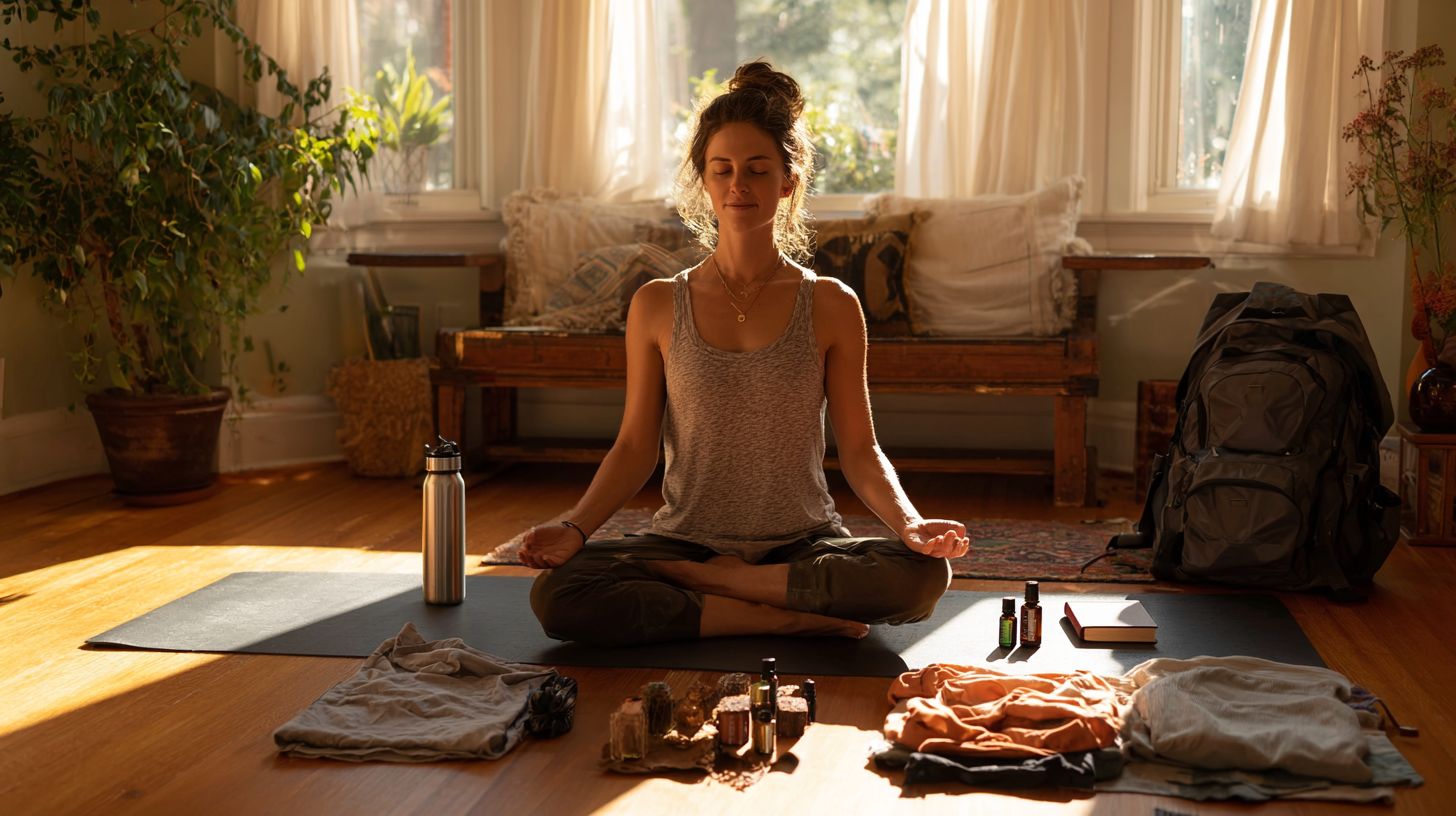
Get 7-8 hours of sleep each night and foam roll three times a week. This cuts soreness by 30%, based on Sleep Foundation data.
To build a strong recovery routine, add these practices backed by evidence.
- Start with an evening wind-down: dedicate 10 minutes to guided meditation via the Calm app ($69.99/year), which studies from the National Sleep Foundation show improves sleep onset by 20%.
- After your yoga session, take 20-minute active recovery walks to improve circulation and lower inflammation, according to the Journal of Athletic Training.
- Take Epsom salt baths two times each week. A 2018 study in the International Journal of Sports Medicine showed that they reduce muscle soreness by 25%.
- Time your day wisely: hit the hay by 10 PM and cut caffeine after 2 PM to avoid disrupting REM cycles, enhancing overall recovery metrics as outlined by Sleep Foundation guidelines.
Mental and Emotional Prep
Mental prep cultivates resilience against emotional overwhelm, building daily meditation habits to manage anxiety before immersion in retreat life.
Daily Meditation Habits
Do 10-minute sessions every day on Insight Timer to build habits. After 21 days, 65% of users report improved focus.
- Download the free Insight Timer app to start. It runs on iOS and Android, and setup takes 2 to 3 minutes.
- Choose beginner-friendly tracks like “Mindful Breathing” by Jack Kornfield or “Body Scan” for relaxation.
- Set up sessions using the app’s notifications-do morning practice while having coffee to build the habit, as James Clear suggests in Atomic Habits.
- Track progress in the journal feature to monitor mood shifts.
- For best results, consistency beats perfection; research published in JAMA Internal Medicine found daily short meditations reduce anxiety by 14% in four weeks.
- Aim for 10 minutes at dawn to build focus steadily.
Managing Expectations and Anxiety
Address anxiety by setting realistic expectations, like anticipating group dynamics but establishing boundaries to prevent overwhelm in 70% of cases per Psychology Today.
To handle common problems, try these three strategies backed by evidence.
- First, combat unrealistic perfectionism by visualizing scenarios using the free CBT app Woebot, which a 2023 NIMH study found reduces self-criticism by 40% in users after two weeks.
- Second, reduce social fears using daily affirmations. Spend 5 minutes repeating phrases like ‘I contribute uniquely.’ A 2023 APA survey found this lowers anxiety in 55% of cases.
- Third, avoid over-scheduling by limiting goals to three per day, preventing burnout as seen in pre-retreat anxiety spikes resolved via 4-7-8 breathing exercises, cutting overwhelm for 68% of participants in recent wellness trials.
Letting Go of Daily Stressors
Release stressors through a 5-step declutter: List top 5 worries, then reframe with gratitude, cutting mental load by 25% in a week.
Follow these actionable steps to implement it effectively.
- Grab a notebook or app like Day One ($35/year) and jot your top 5 worries in 5 minutes, no filtering.
- For each, reframe by noting one gratitude point-e.g., ‘Work deadline’ becomes ‘Grateful for steady income supporting my family.’
- Categorize them: urgent/actionable vs. uncontrollable, using Eisenhower Matrix (free printable from MindTools).
- Tackle one actionable item daily via Todoist ($4/month) tasks; delegate others, like emailing a colleague for help.
- End with a 2-minute breathing exercise from Mayo Clinic’s stress guide, reviewing progress weekly.
This method, backed by a 2020 APA study, reduces anxiety by fostering proactive mindset shifts.
Packing Essentials
Pack wisely to stay comfortable by including yoga gear, layered clothes, and personal care items that match the welcome bags, so you blend into the retreat without issues.
Yoga Gear and Mats
Bring a lightweight Manduka mat (4 lbs, $100) and blocks or straps. These work in different practice areas and are needed for 90% of retreats.
For optimal setup, follow these best practices to keep your gear minimal yet effective.
- Choose non-slip, eco-friendly mats like the Jade Harmony ($70), which aligns with sustainable retreat ethos and provides superior grip during hot yoga sessions.
- Include two cork blocks ($15/set) and a nylon strap ($10) for deeper poses-brands like Gaiam offer durable options.
- Add a quick-dry microfiber towel ($12 from Lululemon) to manage sweat without slipping.
Pack one week ahead using compression bags to avoid bulk; opt for travel-sized essentials like essential oils from Now Foods for post-practice recovery. This streamlined kit weighs under 7 lbs total, ensuring hassle-free mobility across retreat venues.
Comfortable Clothing Layers
Layer with 3-5 moisture-wicking tops like Prana tees ($40 each) and leggings for variable climates in mountain or beach retreat venues.
For efficient packing, follow this checklist for retreat needs.
- Tops: 2-3 breathable, moisture-wicking options like those Prana tees to handle sweat without discomfort-avoid cotton, which retains moisture and can lead to chills, as noted in Travel + Leisure’s packing guides.
- Bottoms: 2 pairs of yoga pants ($50 each) for flexibility during hikes or yoga sessions.
- Outer: A lightweight, packable jacket like the Patagonia Nano Puff ($150) for cool evenings.
Pack smart with these steps:
- Check the forecast using AccuWeather for your venue’s microclimate.
- Roll clothes instead of folding to save 30% more space, per Travel + Leisure tips.
This setup keeps your bag under 20 pounds and allows it to work for different purposes.
Personal Care and Toiletries
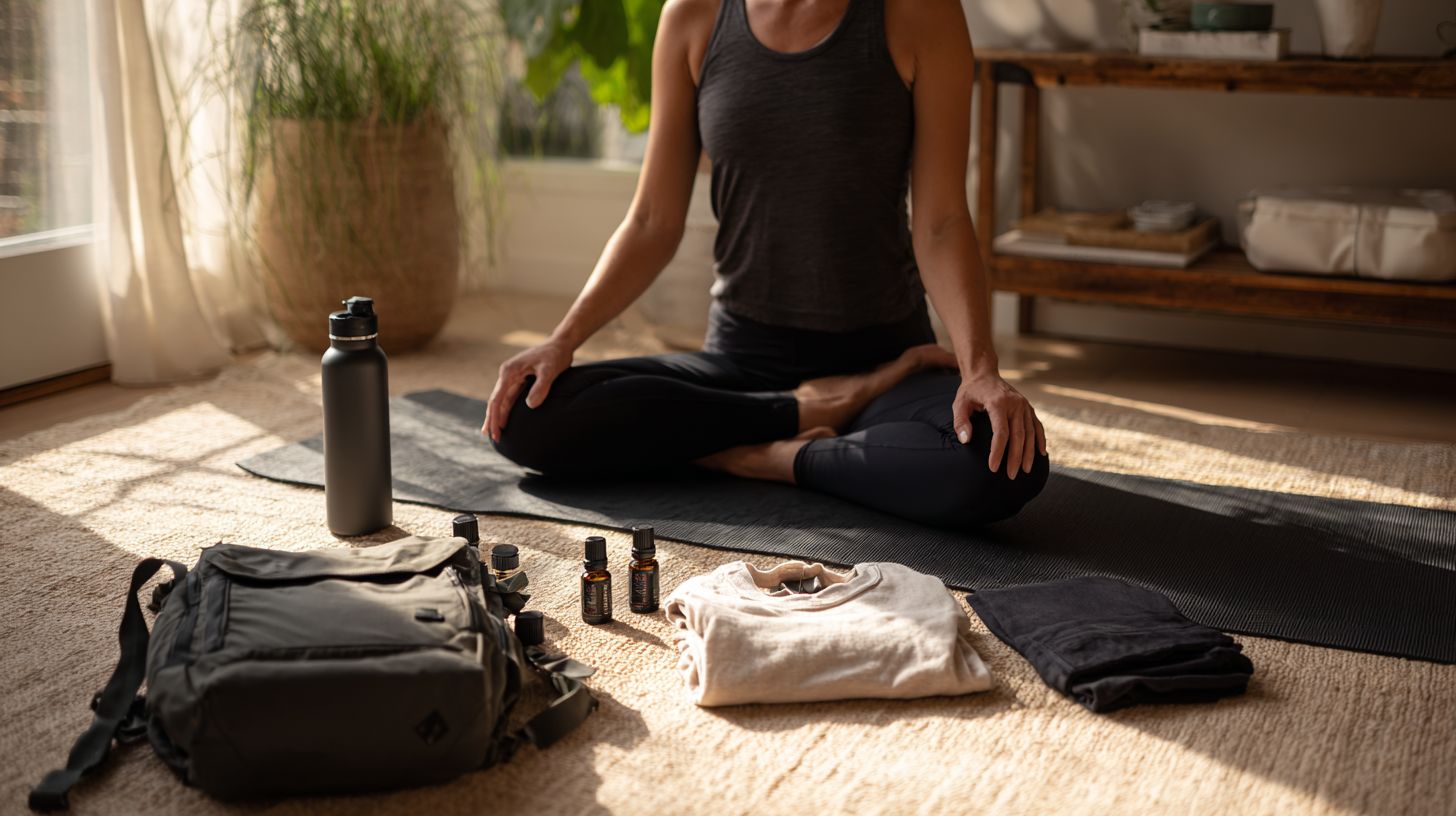
Essentials include travel-sized Burt’s Bees kit ($15) for sunscreen, lip balm, and eco-toiletries to handle noise levels and group meals comfortably.
To further ease travel stress, pack noise-cancelling headphones like the Bose QuietComfort 25 ($129) and a reusable water bottle such as Hydro Flask (20 oz, $25) for hydration during layovers. For group meals, include portable snacks from Kind Bars (variety pack, $8) to avoid dietary surprises.
Follow these best practices:
- Use a TSA-compliant quart-sized bag for liquids;
- Opt for natural calm aids like lavender essential oil from The Body Shop ($10);
- Stock basic meds including ibuprofen and allergy pills.
Assemble your kit three days prior, favoring solid products over glass to comply with FAA regulations and minimize hassle, as per TSA guidelines.
Health and Safety Measures
Prioritize health with consultations and vaccinations, securing liability insurance to safeguard against unexpected challenges during the retreat.
Medical Consultations and Vaccinations
Schedule a check-up 4-6 weeks ahead, verifying vaccinations like Hepatitis A for Bali trips, with 95% compliance recommended by WHO.
This timeline allows boosters like Hepatitis B or typhoid if needed, often covered by travel insurance.
- Start by booking via apps like Zocdoc (free, same-day options available) or your primary care provider.
- During the consult, discuss malaria prevention with doxycycline ($20-50 for 2 weeks, according to guidelines in the CDC’s Yellow Book) and rabies vaccines for outdoor activities.
- Compile documents: passport, medical history, and a yellow fever certificate if transiting Africa.
- Post-visit, monitor for side effects and get a fit-to-fly note.
A 2023 WHO study shows pre-travel prep reduces illness risk by 70%. Total prep time: 1-2 hours, costs $100-300.
Frequently Asked Questions
What essentials should I pack for a yoga retreat?
When preparing for a yoga retreat, essential tips include packing comfortable yoga attire, a mat if not provided, reusable water bottle, journal for reflections, and layers for varying temperatures. How to Get Ready for a Yoga Retreat: Key Advice Bring sunscreen, bug spray, and your personal medicines for a good trip.
How can I physically prepare my body before attending a yoga retreat?
To physically gear up, start a gentle yoga practice a few weeks in advance, focusing on building flexibility and strength. How to Get Ready for a Yoga Retreat: Key Tips Do daily stretches, drink plenty of water, and add light cardio. These steps help prevent soreness and make your sessions more enjoyable.
What mental preparation is key for a successful yoga retreat?
Mental readiness involves setting intentions, practicing mindfulness meditation, and releasing daily stresses. How to Prepare for a Yoga Retreat: Essential Tips emphasize journaling your goals and unplugging from technology to fully immerse in the retreat’s restorative environment.
Should I adjust my diet before a yoga retreat, and how?
Yes, easing into a plant-based or light diet can help; reduce caffeine and processed foods a week prior. How to Prepare for a Yoga Retreat: Essential Tips advise consulting the retreat’s meal plan and hydrating well to align your body with the nourishing foods typically offered.
How do I choose the right yoga retreat for my needs?
Research retreats based on your experience level, location preferences, and focus like Hatha or Vinyasa. How to Prepare for a Yoga Retreat: Essential Tips include reading reviews, checking instructor credentials, and ensuring the schedule matches your energy and goals for an optimal fit.
What should I expect and do on the first day of a yoga retreat?
Arrive early to settle in, attend an orientation, and participate in an introductory session. How to Prepare for a Yoga Retreat: Essential Tips recommend resting well the night before, being open-minded, and connecting with fellow participants to set a positive tone for the entire retreat.
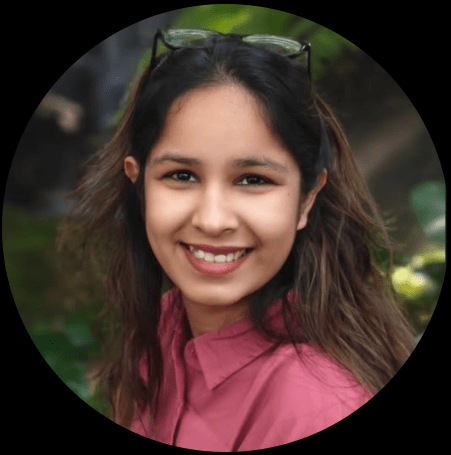
Sheetal Sharda has a background in CS. She got an interest in Holistic living back in 2018, and has since started exploring more into Naturapathy, Holistic Living, Yoga, and more. She got inspired to start SereneClinics to help people find reliable centers across the world.
